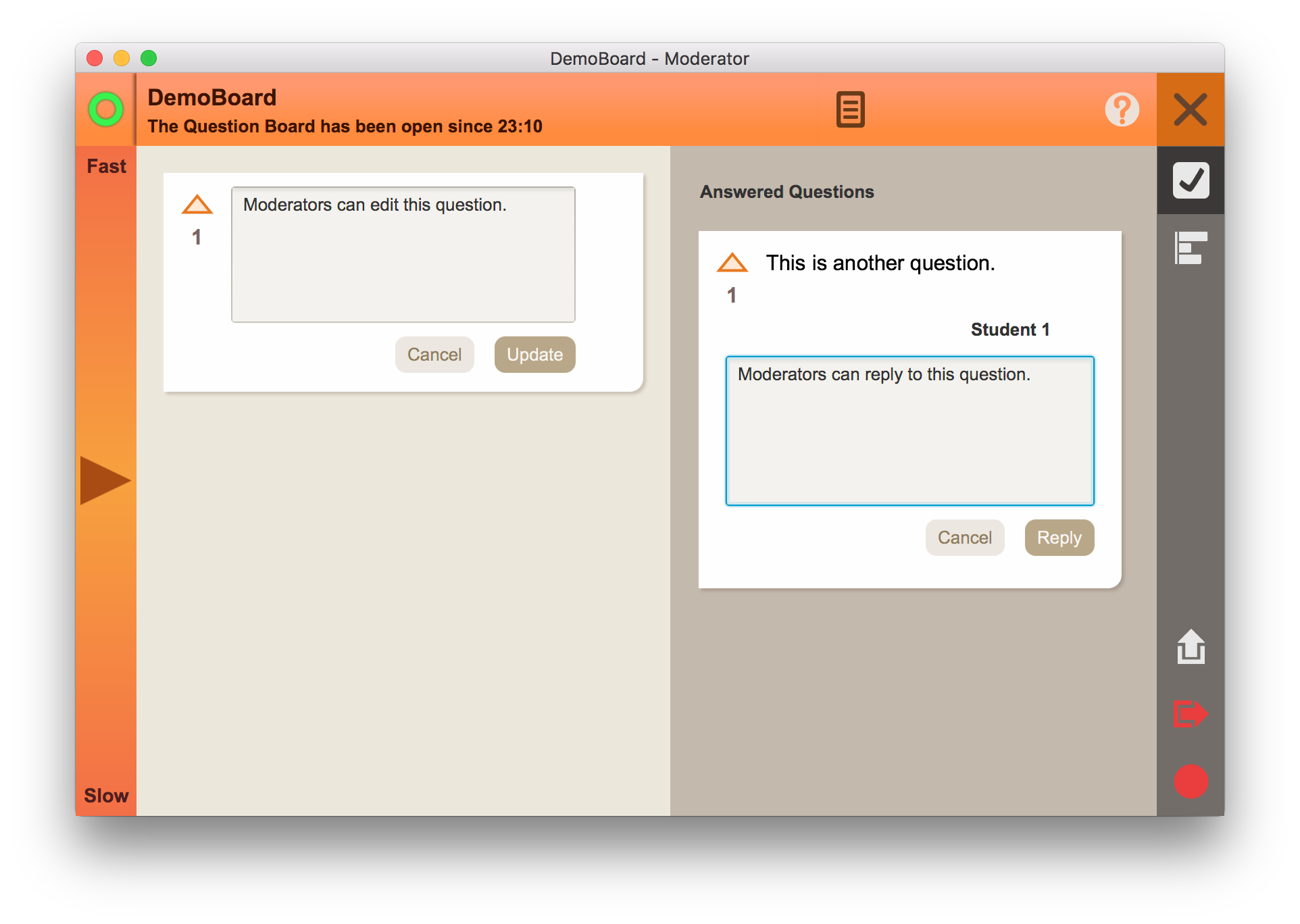QuBo is an application aiming to improve interaction between students and lecturers to make the learning environment better and increase the quality of education. Online education makes communication between students and lecturers more difficult. QuBo alleviates this problem by organising the questions asked by students in an easy-to-follow way so that no question is accidentally looked over. It also has other useful functionality such as live polls and a pace indicator for the lecturer. Its clean user interface and versatile features make it an essential tool for any lecture.
-
Upvoting questions to have them show up first.
-
Adding textual answers and marking questions as answered to keep the board relevant.
-
Separate question boards for each lecture, secured with unique keys.
-
Banning users who misbehave from interacting with a board, as well as the option to set up rate limiting.
-
Real-time poll creation.
-
Anonymity mode
- The application can be set up to store questions in a completely anonymous way by unlinking them from users and IPs without compromising on functionality via single-use tokens. This could be used to make students feel more comfortable when expressing their opinions while giving feedback.
-
Continuous visual pace indicator for the lecturer
- To make it easier for lecturers to know if they are going too fast or too slow, there is an indicator on the left side of the lecturer's screen, which moves up or down in accordance with students' opinions on the pace of the lecture. This is particularly useful in an online setting.
-
Exporting all questions of a board to a file
- At the end of a lecture, lecturers can export all questions and answers to a neatly formatted file and upload them to Brightspace.
- Back end
- The back end uses service-oriented architecture for separation of concerns. Common DTOs are shared between the client and the server to make communication easier. ModelMapper is used to convert entities to DTOs and vice versa. All repositories and services are fully tested through the use of unit tests. The majority of all endpoints, including the most important ones, as well as the parts of the back end they communicate with, are tested via integration tests.
- Front end
- The front end adopts the basic structure of a JavaFX project such that most logic and views are separated into layers. FXML files abstract most user interface designs from the programming logic and view controllers contains the logic to control views. Server communication classes are used to exchange data between the server and the client, all communication methods are fully tested through the use of unit testing. CSS stylesheets are used to enable the separation of effect presentation and view content. The user interface can be automatically tested by using sophisticated robots which mimic real user interactions. Based on these interactions we can assert various expectations, which can easily be tested for.
- Issues
- The expected outcome and any failure cases are clearly outlined.
- All relevant user stories are included in the body (if applicable).
- Big issues are converted into epics and smaller issues are created.
- All issues have the appropriate labels, including priority, current status and issue type. Labels are updated as necessary.
- All issues are assigned a sprint as a milestone depending on when they are to be completed.
- Team members are assigned to issues during team meetings.
- The effort needed for an issue (in terms of both time necessary and difficulty) is estimated and entered as its weight. The initial weight is decided democratically by least two team members. The assignee of an issue updates the weight when they start working on the issue if it turns out to be too high or too low.
- Merge requests
- All merge requests are linked to the corresponding issue(s).
- Labels are assigned.
- Merge requests contain a short summary of the changes made.
- Merge requests must always be approved by at least 2 other team members, including at least one person working on the part of the application the request concerns (front end / back end), unless such a person is currently unavailable and the unmerged request blocks other work from being done.
| 📸 | Name |
|---|---|
| Cassandra Visser | |
| Dorothy Zhang | |
| Gijs van de Linde | |
| Jort van Leenen | |
| Martin Mladenov | |
| Yunhan Wang |
- Run with terminal:
Navigate to the folder (main repository) that contains the .gradle folder.
-
macOS/Linux:
- Use the command
./gradlew server:bootRunto start the server; - Use the command
./gradlew client:runto run the client application.
- Use the command
-
Windows:
- Use the command "gradlew server:bootRun" to start the server;
- Use the command "gradlew client:run" to run the client application;
- Run with Intellij:
- Import the project;
- Run /server/src/main/java/nl/tudelft/oopp/qubo/QuBo.java (server application);
- Run /client/src/main/java/nl/tudelft/oopp/qubo/MainApp.java (client application);
(The gradle version of this application is 6.3)
If you want to contribute, you should avoid failing builds, make commit messages clear and summarize the changes. You should follow our code style as stated in the checkstyle file and test your code properly before submitting. When you create merge requests, you should properly describe what this merge request is about and set correct labels, milestone, and sprint. We will approve your merge request if more than one member of our team believes that your code will not cause problems in our project and can improve the quality of our project to a certain extent.




